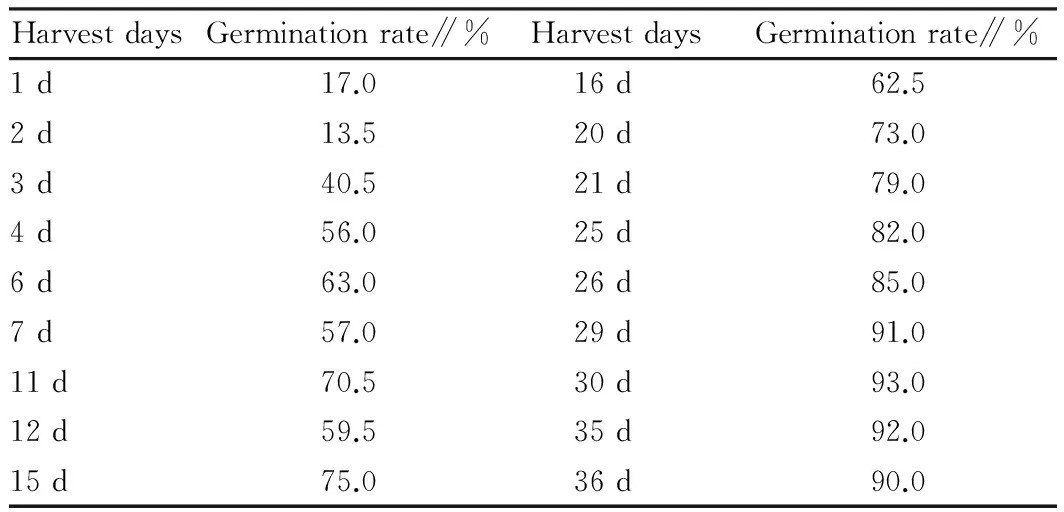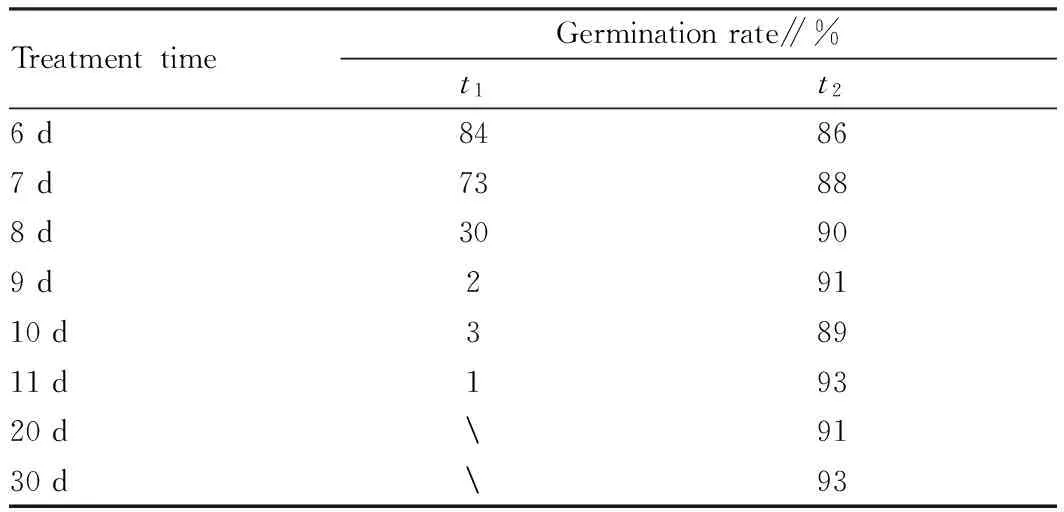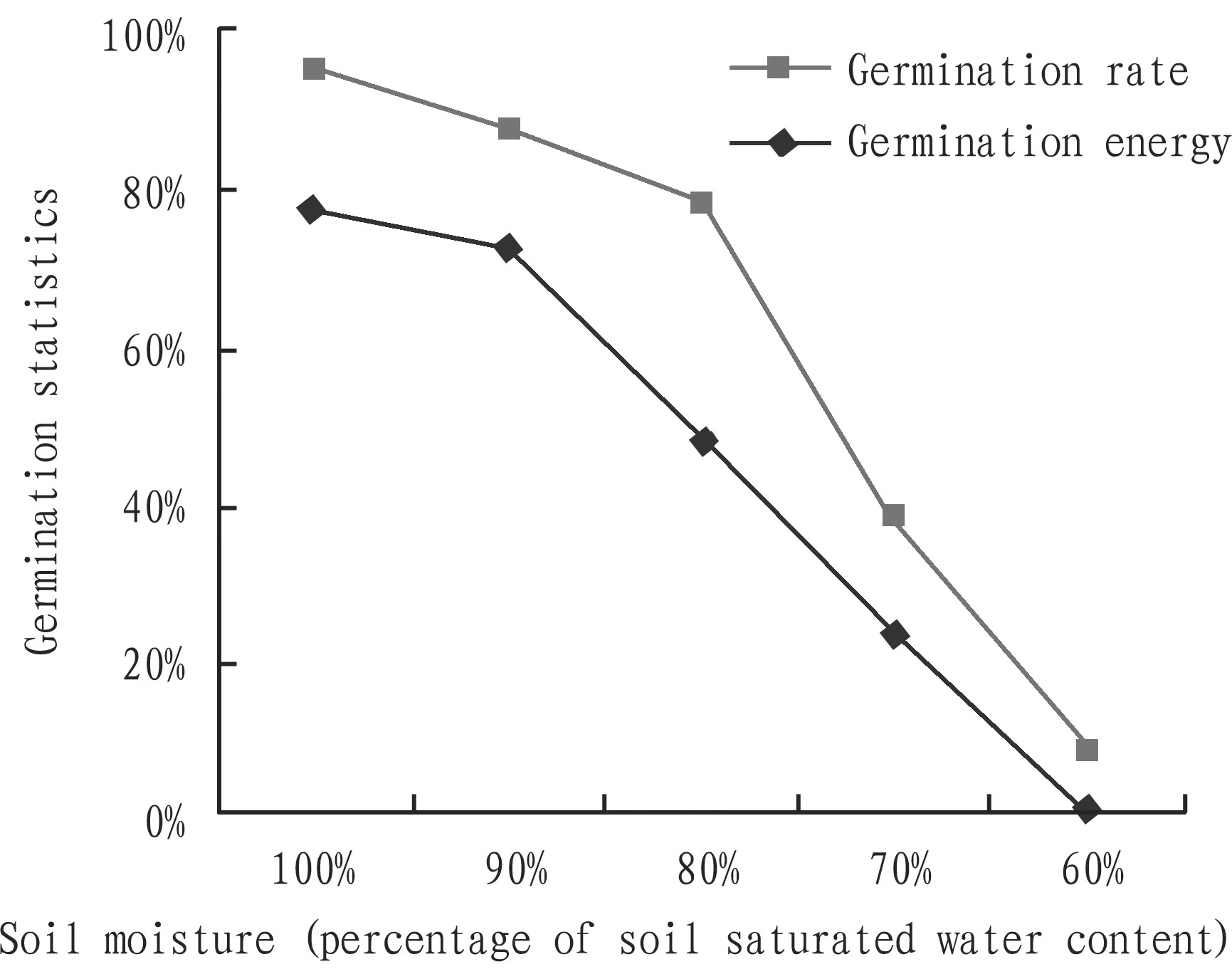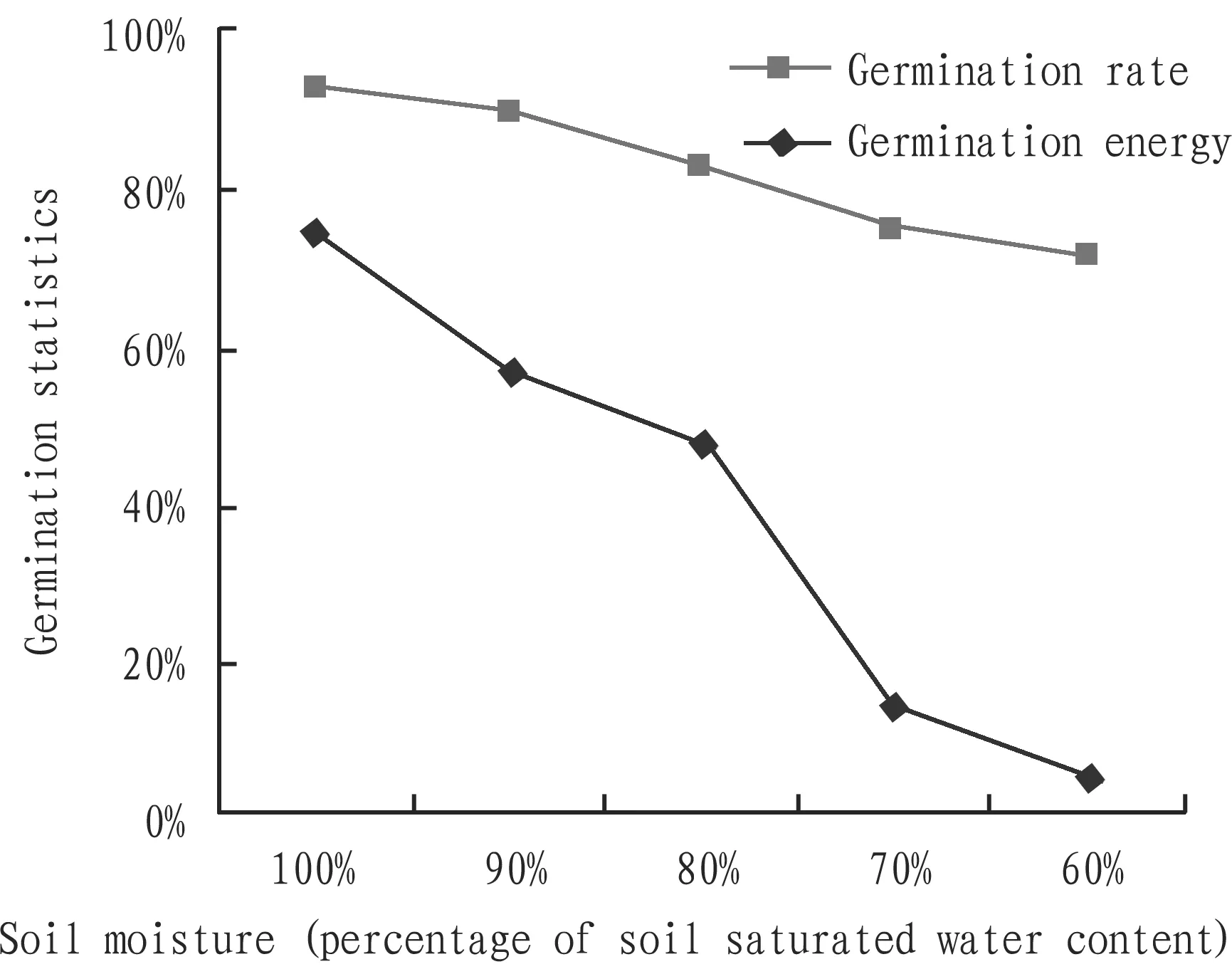Study on Seed Dormancy and Germination Characteristics of Portulaca pilosa
, *, ,
1. Sanya Sci-Tech Academy for Crop Winter Multiplication, Sanya 572000, China; 2.Hainan Tropical Ocean University, Sanya 572022, China
1 Introduction
Portulacapilosais a species of flowering plant in the purslane family,Portulacaceae, distributed in Guangdong, Guangxi, Hainan, Yunnan, Fujian, Taiwan and other places. The roots are fibrous to semi-fleshy. The trichomes are rather obvious at the nodes and are in inflorescence. The plants are annual. The flowering can be from late spring to early fall. It has the features of succulent plant, such as strong drought resistance and stress resistance. It not only has strong vitality, but also has good ornamental value and low cultivation, management and maintenance cost. It is easy to cultivate and survive. Due to ornamental features and drought resistance characteristics, people use it as landscape plant and roof plant[1], and also cultivate it as artificial grass species in orchards in order to add vegetation cover for orchards, protect orchard’s environment and improve the soil structure of orchard.Portulacapilosagrows rapidly, with a variety of seeds, and only takes just ten days from flowering to maturity[2]. After ripening, it is naturally cracked and the seeds are scattered on the ground. The seeding ability is very strong, however, the natural germination rate of the seeds is low, which hinders the rapid propagation. As the grass species cultivated in orchard, the low seed germination rate also limits its population to occupy ground space. In this paper, we explore the dormancy characteristics ofPortulacapilosaseeds, study the seed germination characteristics in terms of light and soil moisture according to the environmental conditions for the growth ofPortulacapilosa, and explore the reason for low natural seed germination rate ofPortulacapilosa, in order to improve the understanding ofPortulacapilosaseeds, find out the measures to improve the seed germination rate, and provide a technical basis for thePortulacapilosaseedling cultivation.
2 Materials and methods
2.1ExperimentalsiteFrom May to November 2015, the experiment was carried out in the experimental base of Sanya Sci-Tech Academy for Crop Winter Multiplication, with geographic coordinates of 18°17′59″N, 109°35′56″E, and elevation of 17 m. It features a tropical marine monsoon climate, with average annual temperature of 25.7°C, annual sunshine time of 2 534 h and average annual rainfall of 1 347.5 mm.
2.2MaterialsThe materials are from the experimental base of Sanya Sci-Tech Academy for Crop Winter Multiplication, and the newly collected seeds and the seeds stored for a month or more. ThePortulacapilosacapsule is mature, and the shell gets waxy yellow, but before natural cracking, the seeds are collected. After the husk and impurities are eliminated, the seeds are stored in a dry place at room temperature.
2.3Methods
2.3.1Germination test. It is conducted in the outdoor natural state, and the method is based onInternationalRulesforSeedTesting. The culture dish with a diameter of 9 cm is as germination box, and four layers of moisturizing tissue are put under culture dish as germination bed. 100 seeds are sown per dish, and they are spread evenly on tissue and covered with permeable filter paper. Then the culture dish cover is closed, and after being repeated three times, it is placed outside the room for germination. Water is added once a day to moisten the germination bed, and it is appropriate when the water on tissue does not drip. The outdoor temperature is 27-33℃ during the test period. According to pre-test observation,Portulacapilosaseeds start to germinate 48 h after the planting, the germination is concentrated on the 3rd day, and the germination continues to the 10th day. Therefore, the germination energy is calculated on the 3rd d, the 7th d is the terminal stage of germination, and the germination rate is calculated. When the seed radicle protrusion length is half the length of seed, it is germinated seed. It is counted once a day, and the germinated seeds are removed so as not to affect the next counting.
2.3.2Determination of seed dormancy period. After harvesting the seeds, the germination test is conducted immediately. When the seed germination rate is more than 80% in two consecutive days, it is seen as release of dormancy; the period when the germination rate is less than 80% is dormancy period; full release of dormancy is in the period when the germination rate is highest.
2.3.3Seed epistotic dormancy test. The seed germination box is put in indoor light conditions (t1, light intensity of approximately 80-200 lx) and dark conditions (t2, light intensity of 0 lx), respectively. After a certain time, the seeds are placed into the light environment, and when the seeds do not germinate completely or only individual seeds germinate, it enters dormancy.
2.3.4Effect of different light intensity on seed germination. The light characteristics of the natural environment wherePortulacapilosaseeds germinate and grow are simulated, and there are four light intensity treatments.T1, simulating natural light conditions, normal light intensity of 30 000-75 000 lx;T2, simulating light conditions under the tree, light intensity of 800-900 lx;T3, simulating densePortulacapilosathicket, light intensity of 100-200 lx; CK, in the dark, light intensity of 0 lx.
2.3.5Effect of different lighting time on seed germination. The freshly picked seeds and the seeds stored at room temperature for a month are used. The lighting time for freshly picked seeds is set to 2, 4, 6, 8, 10 h every day, combined with the treatments 1, 2, 3, 4, 5 d, a total of 25 treatments; the lighting time for the seeds stored at room temperature for a month is set to 1, 2, 3, 4, 5 h every day, combined with the treatments 1, 2, 3, 4, 5 d, a total of 25 treatments. After various treatments, the germination energy is measured on the 3rdd and the germination rate is measured on the 7thd.
2.3.6Effect of different soil moisture on seed germination. The soil taken from the field is brought back to the laboratory, and placed in 105℃ oven for drying, to kill weed seeds. It is dried to constant weight. The soil is ground and sifted to remove gravels and other impurities, and then a certain amount of soil samples (h1) are weighed and put in a small sieve with a layer of filter paper at the bottom. Water is added until the water at the bottom of sieve drips, and after being placed for 24 h and weighed (h2), the soil saturated water content is calculated as: soil saturated water content∥%=(h2-h1)/h1×100. Then it is set to 100%, and different soil moisture is set, expressed by the percentage of saturated soil water content.
3 Results and analysis
3.1Seeddormancycharacteristics
3.1.1Primary dormancy. As can be seen from Table 1, the primary dormancy ofPortulacapilosaseeds varies, and the freshly picked seeds have a certain ability to germinate, but the germination rate is very low. With the passage of storage time in the future, there is a gradual increase in seed germination rate. About 25 d after harvesting, the seed germination rate reaches 80% of production standard, and one month after harvesting, the seed germination rate peaks. The primary dormancy inPortulacapilosaseeds is a way to protect the species survival and continuation, and the self-protection nature of species is very prominent. In the growth environment of extreme discomfort, it can rapidly flower and form seeds[1-2]. The primary dormancy can make the seeds avoid adverse environment to sprout and grow. The seed dormancy characteristics are beneficial to the survival of species, but bring inconvenience to the artificial cultivation, and it is necessary to break seed dormancy before cultivation in order to carry out the next step work.
Table1DormancyofPortulacapilosaseeds

HarvestdaysGerminationrate∥%HarvestdaysGerminationrate∥%1d17.016d62.52d13.520d73.03d40.521d79.04d56.025d82.06d63.026d85.07d57.029d91.011d70.530d93.012d59.535d92.015d75.036d90.0
3.1.2Secondary dormancy. As can be seen from Table 2,Portulacapilosaseed can not be induced in the dark to produce dormancy, but in the low light conditions, it can be induced into dormancy. As for some photoblastic seeds (such asFicushispidaseed), the studies of Chen Huietal.[3]indicate that the Ficus hispida seed germination strictly requires light, and the weak light can delay seed germination, but can not completely inhibit germination. Under low light conditions,Portulacapilosaseeds can not germinate at all, and can be induced into dormancy, which expands the concept of dark dormancy. Dark dormancy is not necessarily generated under dark conditions, and it can be induced in relatively weak light conditions.
Table2Secondarydormancyofseeds

TreatmenttimeGerminationrate∥%t1t26d84867d73888d30909d29110d38911d19320d9130d93
3.2Effectoflightonseedgermination
3.2.1Effect of light intensity on seed germination. As can be seen from Table 3, in outdoor natural light conditions,Portulacapilosa seeds can normally germinate, but in a dark environment, seeds can not germinate, indicating thatPortulacapilosaseeds are photoblastic seeds. In the areas with weak light (under dense grass or tree), the seeds can not germinate, indicating thatPortulacapilosaseed germination places a high demand on light intensity, and the seeds can not germinate when the light intensity can not meet the requirements.
Table3Effectofdifferentlightintensityonseedgermination

TreatmentGerminationenergy∥%Germinationrate∥%T15889T200T300CK00
3.2.2Effect of lighting time on seed germination. As can be seen from Table 4 and Table 5, thePortulacapilosaseeds stored for a month are highly sensitive to light compared with the newly harvested seeds. The newly harvested seeds need light for more than 6 h per day, and germination peak can be reached under light for 3 d. The seeds stored for a month need light for more than 2 h per day, and germination peak can be reached and germination rate required by production can be reached under light for 2 d. After being stored for a certain time, the photosensitivity ofPortulacapilosaseeds is increased, which may be related to post-ripeness after seed harvest. The photosensitizers in seeds are increased with the seed post-ripeness, and the sensitivity of seeds to light is increased.
Table4Effectoflightingtimeonseedgermination

TreatmenttimeLight2h/dGerminationenergy∥%Germinationrate∥%Light4h/dGerminationenergy∥%Germinationrate∥%Light6h/dGerminationenergy∥%Germinationrate∥%Light8h/dGerminationenergy∥%Germinationrate∥%Light10h/dGerminationenergy∥%Germinationrate∥%1d5555331112122d8888121244663d612776470637061864d2412137894798982905d44911839785918894
Table5Effectofdifferentlightingtimeongerminationoftheseedsstoredforamonth

TreatmenttimeLight1h/dGerminationenergy∥%Germinationrate∥%Light2h/dGerminationenergy∥%Germinationrate∥%Light3h/dGerminationenergy∥%Germinationrate∥%Light4h/dGerminationenergy∥%Germinationrate∥%Light5h/dGerminationenergy∥%Germinationrate∥%1d191953546464717480842d303179807575788287903d141482858082909694974d252578806573909291955d33378188849088919195
3.3EffectofsoilmoistureonseedgerminationFig. 1, 2 show that soil moisture is closely related to germination energy and germination rate ofPortulacapilosaseeds. Greater soil moisture will lead to higher seed germination energy and germination rate, and when the soil water holding capacity is at saturation, the seed germination energy and germination rate reach the highest value. Studies have shown that many seeds have suitable soil moisture for germination. Chang Weietal.[4]study the effect of soil moisture on the seed germination ofPiceacrassifolia,PotentillafruticosaL., and bark or stem of Shagspine Peashrub, and find that the best moisture for germination of the three kinds of plants varies. The seed germination ofPortulacapilosaprefers humid soil environment, and high soil moisture is favorable to the seed germination. As can be seen from Fig. 2, the germination rate of the seeds stored for a month is slightly affected by insufficient soil moisture, but the germination energy is greatly affected, far from reaching the germination energy level on the paper germination bed, which may be related to insufficient water absorption of the

Fig.1Effectofsoilmoistureongerminationofthenewlyharvestedseeds
seeds due to water loss on the sandy soil germination bed. As shown in Fig. 1, both the germination energy and germination rate of newly harvested seeds are low, because the germination base of newly harvested seeds is small, or seed’s water absorption on the sandy soil germination bed is more difficult than on the paper germination bed, reducing the overall germination rate of seeds.

Fig.2Effectofsoilmoistureongerminationoftheseedsstoredforamonth
4 Conclusions and discussions
There is primary dormancy in the newly harvested seeds ofPortulacapilosa, and the dormant period is about 25 d. The storage at room temperature for one month or more can completely release dormancy. The newly harvested seeds have a certain germination ability, but the germination rate is low. In production, the newly harvested seeds should be stored at room temperature for a month or more before planting, so as to improve seed germination rate.Portulacapilosaseeds are positively photoblastic seeds that place a strict demand on the light intensity. Only after the seeds are exposed to strong light can they germinate, and the light intensity demand needs to be further studied. The relevant studies show that light can promote the seed germination of many weed plants, especially for the plants with small seeds, such asHibiscustrionumL.,Atriplexoblongifolia,EuphorbialathyrisL., andEleusineindica(L.)Gaertn[5-8]. The small seeds contain limited starch and other storage materials, and only when the seeds are located on shallow soil surface and the light conditions are good can enough energy be supplied to embryo for germination[9-10]. ThePortulacapilosaseed is very small, and the weight of 15000 seeds is about 1 g[1]. Taking the photoblastic seed strategy is the result of long-term adaptation of species to environment and natural selection. Some studies show that photoblastic seeds have light requirements, because the seeds have phytochrome inside[11-12]. Phytochrome consists of proteins and pigment groups, and pigment groups have unique light absorption properties, and play the role by binding with proteins. The phytochrome inside seeds includes red-absorbing form Pr and far-red-absorbing form Pfr, and the two forms of phytochrome can transform into each other after specific spectrum absorption. The light-sensitive seeds use light to adjust the level ofPfr/(Pfr+Pr) inside seeds, and when it reaches a suitable ratio, the germination process can be started[13]. Different seeds have differentPfr/(Pfr+Pr) values suitable for germination, even for the different seeds in the same fruit, as demonstrated by the differences in sensitivity to light between seeds[14-18]. There are great differences in changes of sensitivity to light between different seeds. For some light-sensitive seeds, the photosensitivity will disappear after a certain time of ripening; the photosensitivity of some seeds can be long preserved, such as water lettuce seeds[9]. According to the results of this study,Portulacapilosaseeds fall into the type of enhanced photosensitivity after harvesting. Soil moisture is the main factor affecting germination rate ofPortulacapilosaseeds. The results in this study show that high soil moisture will lead to high germination energy and germination rate ofPortulacapilosaseeds, and with the decline in soil moisture, the germination rate gently decreases, while the germination energy sharply decreases. Under natural conditions, insufficient soil moisture is the main reason for low germination rate ofPortulacapilosaseeds, and the secondary reason is the lack of light under the grass.Portulacapilosaseeds can be immediately harvested and sowed, but the germination rate is low. If the seedling is of great urgency, we can use the newly harvested seeds.Portulacapilosaseeds are photoblastic seeds which place high demand on light intensity, and they can not germinate in low light conditions.Portulacapilosaseeds favorite humid conditions, and the higher the soil moisture, the higher the germination rate and germination energy of the seed. During direct sowing ofPortulacapilosaseedlings, we recommend that the seeds should be first placed in the transparent culture dish covered with moisturizing tissue before sowing after 2-3 d of germination in strong light conditions. After sowing, it is covered with transparent plastic film to keep moisture and light, which is conducive to the emergence of seeds.
[1] XU ZP, TAN JP, LI YP,etal.Portulacapilosa’s application in landscaping in Southern China[J]. Journal of Green Science and Technology, 2015(1):89-92.(in Chinese).
[2] GONG JJ, YANG XF. Propagation and cultivation techniques ofPortulacapilosa[J].Modern Agricultural Science and Technology, 2015(20): 122-123. (in Chinese).
[3] CHEN H, ZHANG S, CAO M. Effects of light and temperature on seed germination of Ficus hispida in Xishuangbanna, southwest China[J]. Acta Phytoecologica Sinica, 2008, 32(5): 1084-1090. (in Chinese).
[4] CHANG W, WU JG, LIU YH. The effects of temperature and soil water content on the seed germination of three typical plants distributing in Qilian Mountains[J]. Chinese Horticulture Abstracts, 2010(4): 1-6. (in Chinese).
[5] CHACHALIS D, KORRES N, KHAH EM. Factors affecting seed germination and emergence of Venice mallow(Hibiscus trionum)[J]. Weed Science, 2008, 56:216-223.
[6] NURSE RE, REYNOLDS WD, DOUCET C,etal. Germination characteristics of thedimorphic seeds of spreading orach (Atriplex patula)[J]. Weed Science, 2008, 56: 216-223.
[7] CHAUHAN BS, JOHNSON DE. Germination ecology of Chinese Sprangletop (Leptochloa chinensis)in the Philip-pines[J]. Weed Science, 2008, 56: 820-825.
[8] CHAUHAN BS, JOHNSON DE. Germination ecology of goosegrass (Eleusine indica):An important grass weed of rainfed rice[J]. Weed Science,2008,56:669-706.
[9] ZHAO DL. Effect of light on seed dormancy and germination[J]. Bulletin of Biology, 1995, 30(7): 24-28. (in Chinese).
[10] HALMER P, BEWLEY JD. DAI RC. The physiological prospect of the determination of seed vigor[J]. Seed, 1986 (3): 68-71. (in Chinese).
[11] WANG YX. Review on influence mechanisms of light in seed germination[J]. Beijing Agriculture, 2015(10):44-45.(in Chinese).
[12] ZHANG M, ZHU JJ, YAN QL. Review on influence mechanisms of light in seed germination[J]. Acta Phytoecologica Sinica, 2012, 36(8): 899-908. (in Chinese).
[13] YANG QH, SONG SQ, YE WH,etal. Mechanism of seed photosensitivity and factors influencing seed photosensitivity[J]. Chinese Bulletin of Botany, 2003, 20(2): 238-247. (in Chinese).
[14] LIAO JL, FANG JX. Influences of CCFL supplemental lighting on seed germination and seedling growth of okra[J]. Guangdong Agricultural Sciences, 2015, 42(21): 35-39. (in Chinese).
[15] YANG CJ, WEI SH, ZHOU QX,etal. Effects of illumination and seed-soaking reagent on seed germination of Solanum nigrum[J]. Chinese Journal of Applied Ecology, 2009, 20(5): 1248-1252. (in Chinese).
[16] LI LG, HE LP. Effects of different light and GA3 on the germination and seedling growth of Rhodiola sachalinensis[J]. Journal of Chinese Medicinal Materials, 2011, 34(3): 327-331. (in Chinese).
[17] HE LP, LI G. Studies on the effect of different varieties lettuce seeds germination treated by light[J]. Seed, 2009, 28(7): 31-33, 37. (in Chinese).
[18] ZHANG MR, LI XJ. Effects of light on seed germination and plant growth of the invasive weed Flaveria bidentis[J]. Plant Protection, 2010, 36(1): 99-102. (in Chinese).
 Asian Agricultural Research2016年11期
Asian Agricultural Research2016年11期
- Asian Agricultural Research的其它文章
- Feasibility Analysis of Agricultural Product Price Index Insurance Based on Pilot Cases
- Forecast on Price of Agricultural Futures in China Based on ARIMA Model
- Model Building for Community Participating in Rural Tourism and Game Analysis of Core Stakeholders
- Embedded Programmable Single Point Multiple Output Intelligent Data Acquisition and Transmission System
- A Study of the Factors that Affect Farmers’ Willingness to Transfer Land in the Central Regions Based on a Survey of 180 Farmers in Suizhou City
- Comparative Study of Cotton Plant Height Difference in the Arid Areas Based on LandSat8 OLI Data
